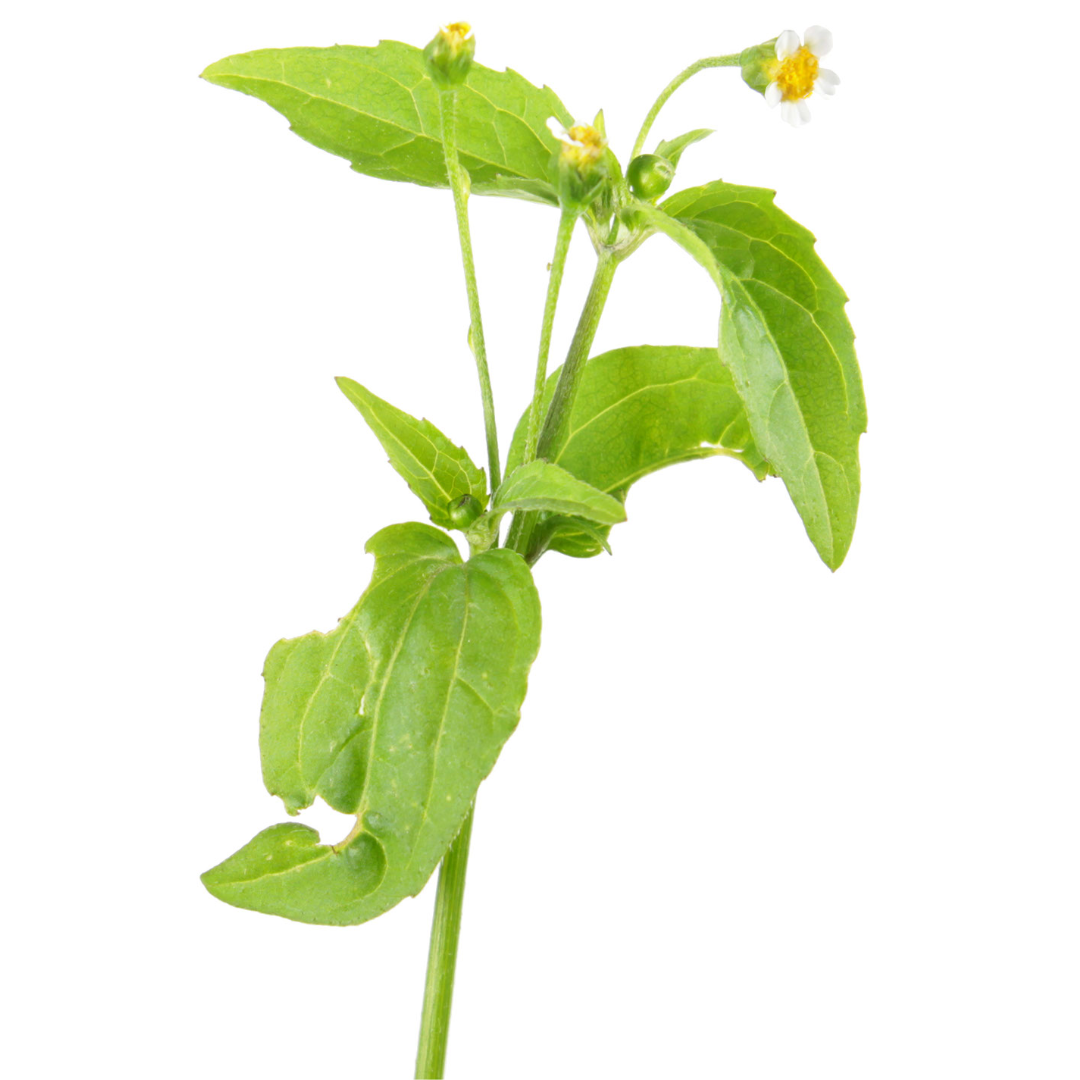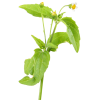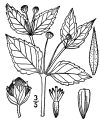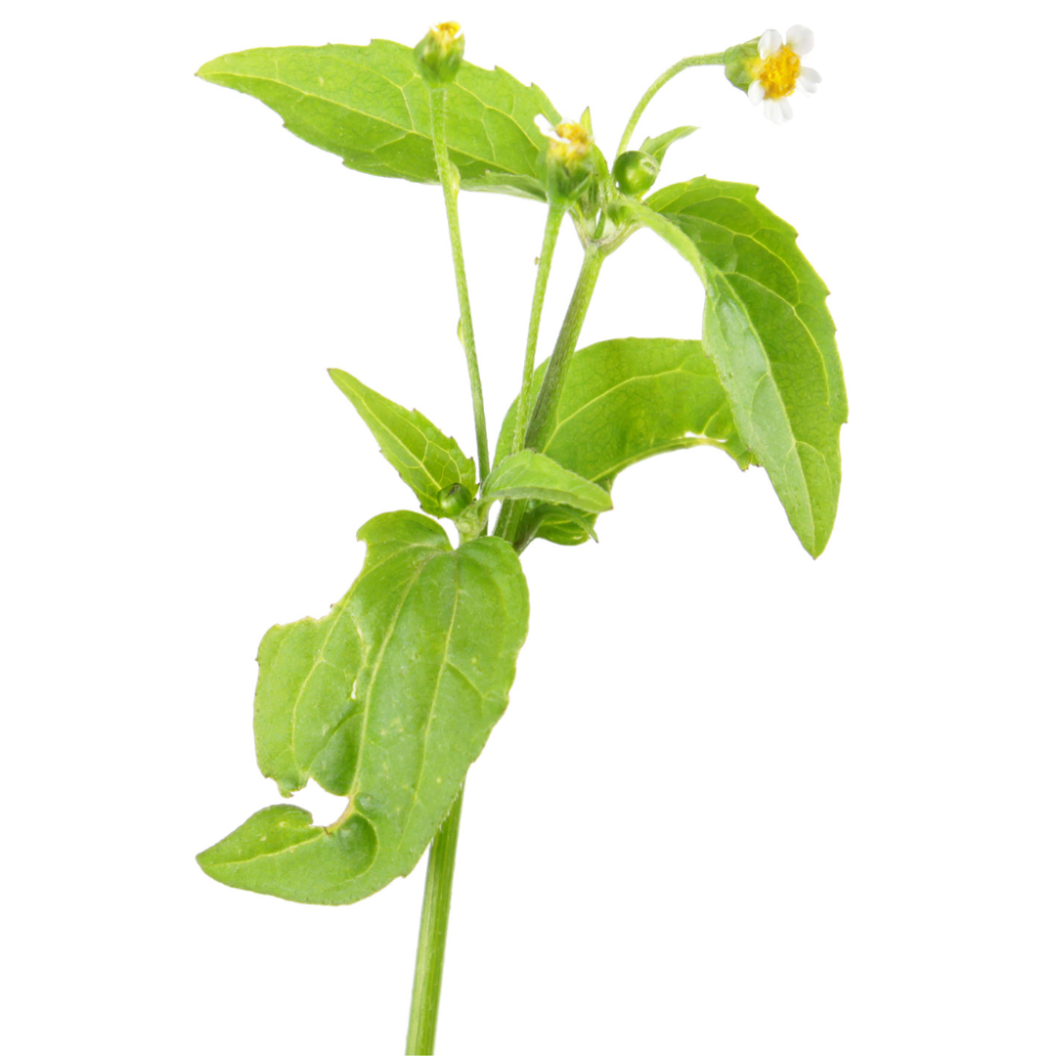


Quickweed
DESCRIPTION: Quickweed is a type of plant that you might find growing in your garden or along the side of the road. It's a tall, green plant with small, yellow flowers that bloom in the summer. The leaves are thin and pointed, and they grow in pairs along the stem. Quickweed gets its name because it grows very quickly, spreading rapidly and taking over other plants in the area. While some people might see it as a pesky weed, others appreciate its beauty and use it in herbal remedies.
SCIENTIFIC NAME: Galinsoga parviflora
OTHER NAMES: Gallant Soldier, Shaggy Soldier, Peruvian Daisy, Potato Weed
LEAF TYPE: Broadleaf
FLOWERS: Quickweed flowers are small and daisy-like, with bright yellow petals surrounding a small center disk. They grow in clusters at the top of the plant and can bloom throughout the summer. The petals are delicate and slightly wrinkled, and the center disk is made up of tiny yellow flowers that are tightly packed together. The flowers are quite pretty and can attract bees and other pollinators.
LEAVES: Quickweed leaves are small and pointed, with a bright green color. They grow in pairs along the stem, and have a slightly serrated edge. The leaves are relatively thin and delicate, and have a slightly hairy texture. When you crush the leaves, they can have a slightly minty or herbal smell. The leaves are an important feature for identifying the plant, as they are unique in shape and arrangement.
LIFE CYCLE: Annual
HOW TO IDENTIFY: Quickweed is a fairly easy plant to identify. It has bright green leaves that grow in pairs along the stem and are slightly pointed. The plant can grow to be up to three feet tall, and has small, yellow, daisy-like flowers that bloom in clusters at the top of the stem. When you crush the leaves, they can have a slightly minty or herbal smell. Quickweed can sometimes be mistaken for other similar-looking plants, but its unique leaf arrangement and yellow flowers are key features that can help you identify it.
MECHANICAL CONTROL RECOMMENDATIONS:
1. Hand pulling - More Info
2. Hoeing - More Info
3. Tilling - More Info
4. Aeration - More Info
5. Mulching - More Info
6. Mowing - More Info
7. Flame Weeding - More Info
8. Solarization - More Info
9. Cultivation - More Info
CHEMISTRY RECOMMENDATIONS:
"Pre-emergent herbicides:
Oryzalin: This herbicide is commonly used to control a broad spectrum of annual grasses and broadleaf weeds, including Galinsoga parviflora. It's often applied before weed seeds germinate and should be watered into the soil.
Pendimethalin: Another pre-emergent herbicide that works by inhibiting weed seed germination. It can provide effective control of various annual grasses and broadleaf weeds.
Dithiopyr: This herbicide can provide pre-emergent control of both grassy and broadleaf weeds, including Galinsoga parviflora. It's often used on lawns and turf as well as in certain garden settings.
Isoxaben: This herbicide targets broadleaf weeds and works by inhibiting cell wall synthesis in germinating weed seeds. It can be effective against Galinsoga parviflora and other broadleaf weeds.
Trifluralin: Trifluralin is commonly used in agricultural and garden settings as a pre-emergent herbicide. It helps prevent the growth of various annual grasses and broadleaf weeds.
Prodiamine: This herbicide is often used to prevent the germination of weed seeds and can provide effective control of Galinsoga parviflora and other weeds.
Benefin: Benefin is a pre-emergent herbicide that targets grassy and broadleaf weeds, making it potentially effective against Galinsoga parviflora.
Trifluralin + Isoxaben: Some herbicides are formulated with a combination of active ingredients for broader weed control. A combination of trifluralin and isoxaben, for example, might offer effective control of both grassy and broadleaf weeds, including Galinsoga parviflora.
Post-emergent herbicides:
2,4-D: This is one of the most widely used post-emergent herbicides for controlling broadleaf weeds. It's effective against many common weeds, including Galinsoga parviflora. It's often found in various herbicide formulations.
Dicamba: Dicamba is another commonly used herbicide for broadleaf weed control. It's often used in combination with other herbicides to enhance effectiveness and manage weed resistance.
MCPA: MCPA is a selective post-emergent herbicide that targets broadleaf weeds, including Galinsoga parviflora. It's often used in lawns, pastures, and non-crop areas.
Clopyralid: Clopyralid is effective against a range of broadleaf weeds, including Galinsoga parviflora. It's commonly used in various settings, including lawns, turf, and non-crop areas.
Triclopyr: Triclopyr is used to control both broadleaf and woody plants. It's effective against a variety of broadleaf weeds and can be used in various applications.
Glyphosate: Glyphosate is a non-selective herbicide that can control a wide range of weeds, including Galinsoga parviflora. However, it will also kill desirable plants, so it should be used with caution and only in areas where you want to completely eliminate vegetation.
Aminopyralid: Aminopyralid is often used in pasture and rangeland settings to control a variety of broadleaf weeds, including Galinsoga parviflora.
Carfentrazone: Carfentrazone is a fast-acting herbicide that's effective against many broadleaf weeds. It's often used in combination with other herbicides for better control.
Selective herbicides:
2,4-D: A commonly used selective herbicide for controlling broadleaf weeds in lawns, pastures, and non-crop areas. While it targets many broadleaf weeds, it can also harm certain ornamental broadleaf plants, so caution is needed.
MCPA: Another selective herbicide effective against a range of broadleaf weeds. It's often used in lawns, pastures, and non-crop areas.
Triclopyr: This herbicide is effective against a variety of broadleaf weeds, including some woody plants. It's often used in both residential and commercial settings.
Clopyralid: Selective against broadleaf weeds, clopyralid is commonly used in turfgrass, non-crop areas, and some agricultural settings.
Aminopyralid: Used for controlling broadleaf weeds in pastures, rangelands, and non-crop areas. It's effective against certain invasive broadleaf plants.
Fluroxypyr: Effective against a range of broadleaf weeds, fluroxypyr is used in various settings, including lawns and ornamental beds.
Quinclorac: While primarily used for controlling crabgrass, quinclorac can also target some broadleaf weeds. It's often used in lawns and turfgrass.
Sulfentrazone: This herbicide targets a variety of broadleaf weeds and is used in both residential and commercial applications.
Non-Selective herbicides:
Glyphosate: Glyphosate is one of the most widely used non-selective herbicides. It's effective against a broad spectrum of weeds, including Galinsoga parviflora. Glyphosate is often used for large-scale weed control, such as in agricultural fields or areas that need complete vegetation removal.
Glufosinate: Glufosinate is another non-selective herbicide used to control a variety of weeds. It's often used in agricultural and non-crop settings.
Paraquat: Paraquat is a fast-acting non-selective herbicide that can quickly desiccate and kill vegetation. It's often used for spot treatments in non-crop areas.
Diquat: Diquat is used for contact control of a variety of aquatic and terrestrial weeds. It's often used in aquatic settings and non-crop areas.
Pelargonic Acid: Also known as ""horticultural vinegar"" or ""natural weed killer,"" pelargonic acid-based herbicides are considered organic options for non-selective weed control. They can kill weeds on contact by disrupting cell membranes.
Vinegar-Based Herbicides: Vinegar-based herbicides are often used for non-selective weed control. They contain acetic acid and work by dehydrating plants upon contact. They may be less effective on established weeds with deep root systems.
Herbicidal Soap: Soap-based herbicides are designed to break down the waxy cuticle on plant leaves, causing dehydration and killing plants on contact. They are often used for spot treatments.
Recommended Prevention
Recommended Control

